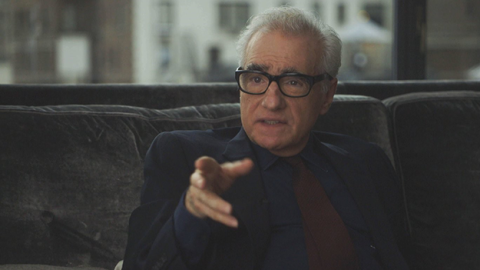Film of the Week: Hitchcock/Truffaut
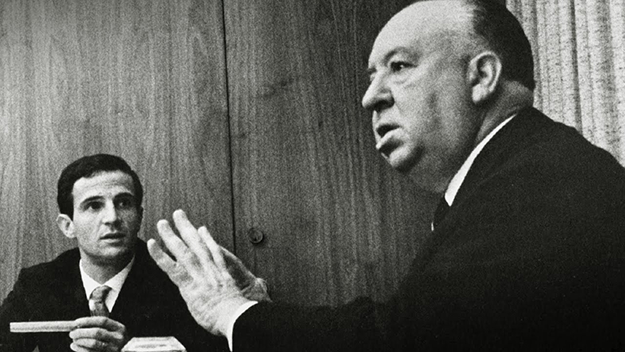
Hitchcock/Truffaut is, as you might imagine, a film about Alfred Hitchcock and François Truffaut, and specifically about the interviews that Truffaut conducted with his idol in August 1962—resulting in the book originally published in 1966 as Le Cinéma selon Alfred Hitchcock and best known in English under the same title as this documentary. Directed by NYFF director and FILM COMMENT deputy editor Kent Jones, and written by him and French critic, scholar, and Truffaut biographer Serge Toubiana, this documentary could just as aptly have been titled Hitchcock/Truffaut/Scorsese/Fincher/Assayas/Linklater/etc. It’s a film that reminds us that filmmakers, whether or not they’re expert at discussing their own work, really let their critical and analytical imaginations flow when they get talking about the work of a director they really admire. All the more so when it’s Hitchcock.
That’s partly because the English maestro is not really a father figure in the classic sense. You can’t imagine some of Jones’s interviewees getting quite as excited or as voluble about, say, Ingmar Bergman or Jean Renoir—or at least, having as much fun talking about them. The pantheon of cinematic greats contains many a revered patriarch of the sort that can freeze admirers into cowed reverence. What Hitchcock represents is a mischievous uncle—someone who liked to revel in, and encouraged others to revel in, audacious and often disreputable fun, both as viewers and as practitioners. Hitchcock in his time attracted, and continues to attract, much high-cultural reverence: Jean-Luc Godard was at once challenging the cultural canon and reasserting its traditional values when he said, “a new Hitchcock film can be as important in the history of art as a new book by Gide or Aragon.” But among this film’s interviewees, it’s perhaps Kiyoshi Kurosawa who best pinpoints Hitchcock’s ambivalent status, and his appeal to generations of aspiring cinematic troublemakers, when he notes: “He portrayed himself as a mainstream figure [but] he’s really at the farthest edge of things.”
There’s certainly one moment in Hitchcock/Truffaut when Hitchcock’s persona as a vaudevillian farceur makes itself felt. He’s discussing the moment in Vertigo when Kim Novak’s character frustrates James Stewart’s Scottie by refusing to go, so to speak, all the way with the imposture he’s demanding, stopping short of wearing her hair in the peculiar way that he has fetishized. As we hear Hitchcock put it in the interview: “She has stripped but she won’t take her knickers off.” There now follows on the tape the sound of Truffaut responding with a coy, slightly embarrassed chuckle, like a schoolboy being told a dirty joke by a cheerfully louche uncle who’s seen the world a bit. At which point, Hitchcock rewards Truffaut further, by saying to him and Helen Scott—Truffaut’s co-author on the book, and translator at the sessions—“I will now tell a story—shut the machine off.”
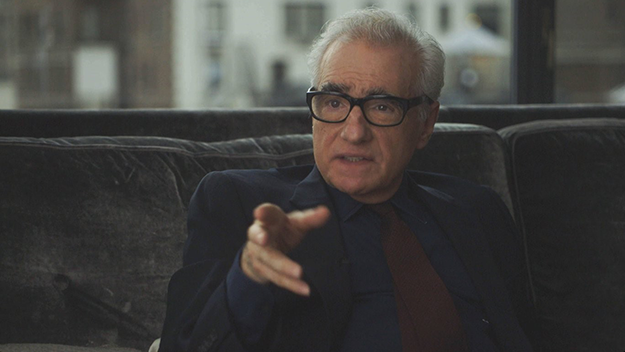
This is one of the moments in the documentary at which we become signally aware of the spoken interviews not simply as the original form of a text which has been for nearly 50 years, but as a live dialogue—and it never becomes more alive than when it’s interrupted, as it is here. The other interruption comes when Truffaut cautiously asks Hitchcock about the part played by Catholicism in his filmmaking—and Hitchcock says: “Go off the record.” His answer is cloaked by silence and a black screen, evoking the confidentiality of the confessional booth itself, the young filmmaker abruptly becoming father confessor to his own adoptive patriarch.
The film begins by sketching out how Truffaut, already the director of three features, visited Hitchcock at Universal (together with Scott—and it would have been good to know more about her and the role she played in the sessions and the subsequent editing). With the use of Philippe Halsman’s black-and-white photos, the interview tapes themselves, and ample illustrations from Hitchcock’s films—and one or two of Truffaut’s—the documentary walks us through the interviews and the key questions arising. The juiciest aspect of the documentary, for film students and general cinephiles alike, will be that Jones gets other directors talking—which in some cases, notably David Fincher’s, illuminates their own work as much as Hitchcock’s. Jones has assembled a starry cast, if a limited one; inevitably, you use who you can get, but with the exception of Kurosawa, the contributors are either American (Scorsese, Schrader, Bogdanovich, Linklater, Wes Anderson, James Gray) or French (Assayas, Desplechin). There are no women, and you wonder what might have been offered by Claire Denis, Kathryn Bigelow, or Jane Campion, given her own somewhat Hitchcockian In the Cut, and it would have been interesting to have an Italian of the giallo persuasion in the mix.
Nevertheless, the contributions are generally illuminating; it’s always fun hearing Scorsese warm to a topic (you really feel Hitchcock is an element he swims in like a seal). Fincher offers one of the most incisive formulations of Hitchcock’s attitude to actors. It comes after a discussion of Montgomery Clift’s resistance to a certain instruction in I Confess (which was designed simply to draw our attention to a hotel across the road from his character); Hitchcock complains about Clift’s presumption in “organizing my geography,” before making his notorious equation of actors and cattle. Fincher points out that, given what his visual precision did for the complex depiction of psychology in movies, Hitchcock didn’t want actors to spoil his calculations. Or, as Fincher puts it, it’s all about “not allowing it to spill over the edge of the bucket”—which expresses the art of control, and the potentially ruinous effect of uncontained performance, quite superbly. No less quotably, Fincher imagines the likes of De Niro, Pacino, and Hoffman “trying to flourish under the iron umbrella of ‘this is what this next three-and-a-half seconds is about.’”
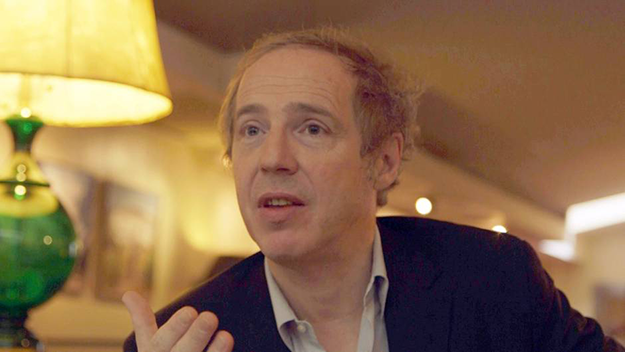
Among the other commentators, suffice to say that the French are more French, in their penchant for a certain abstraction. Olivier Assayas nails it when he talks about a “hyper-perception of objects” in Hitchcock’s films, but I’d question his contention that Truffaut isn’t a stylist. Shoot the Piano Player? Fahrenheit 451? Mississippi Mermaid? Let’s say at least that sometimes he chooses to be a stylist and sometimes not. Meanwhile Arnaud Desplechin catches better than anyone the sheer excitement of getting caught up in the Hitchcockian imagination, and rather magnificently keeps alive a certain tone of old-school Cahiers “poetic criticism,” if you like, when he says of The Wrong Man: “It’s impossible to make a film like that without trembling with empathy for every gesture, every moment, every object.”
This documentary will remind you of a lot that you already knew about Hitchcock, but casts different light on much of it, and tells us a lot more besides—I’m amazed we’re not all already walking around quoting Hitchcock’s observation that “There’s no such thing as a face—it’s non-existent till the light hits it.” The film also avoids a lot of commonplaces. That old warhorse the MacGuffin is given a rest, and the clips used are not always the canonical great moments: the image the film first lingers on Oscar Homolka’s ominously knitted brows in Sabotage. And the definition here of suspense is one that stresses that it’s not always a matter of fear, but simply about the delay of resolution. That’s illustrated by a scene from Easy Virtue (28) in which the eventual plighting of the central couple’s troth is marked by an extended reaction shot showing an eavesdropping telephone operator—a deliciously dizzy bit of character comedy from an actress unnamed here (and, I believe, in the original film), Benita Hume.
You sometimes wish for more Truffaut—and perhaps, more of his contemporaries. In emphasizing how much Truffaut’s book did for making his hero respectable, it arguably underplays the work done by Eric Rohmer and Claude Chabrol in their 1957 book on the director, which Truffaut acknowledges in his introduction. And you wish there had been more on precisely what Truffaut learned from Hitchcock—whether, for example, 1962’s immersive spell in the man’s thought processes specifically inflected the films he went on to make immediately after. We do get quite a bit of Truffaut, however, and a sense of Hitchcock’s generosity and curiosity towards his interlocutor, notably when he asks the French director to describe for him the scene in The 400 Blows in which Antoine Doinel spots his mother kissing—as it were—the wrong man.
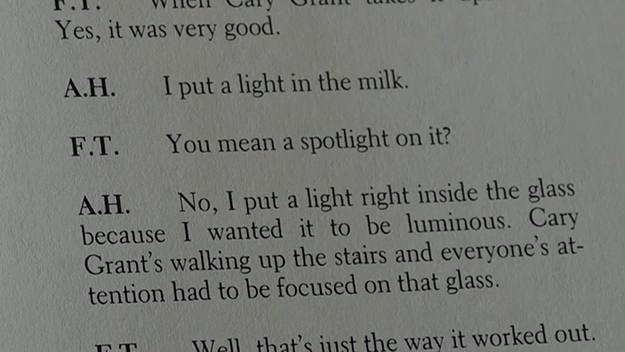
Poignantly, exposure to a younger director who was on the rise and reinventing the rules made Hitchcock wonder whether he ought to have worked differently himself: “Should I have experimented more with character and narrative?” he wonders in his later correspondence with Truffaut. He wonders whether he has become a prisoner of his own form, and expresses this dilemma in a telegram to Truffaut in terms which pose a specially teasing riddle for all philosophers of auteurism: if he did attempt to do things differently, Hitchcock says, “It would be like the painter Mondrian trying to paint a Cezanne . . . Maybe he can but who would accept it.”
The film ends with a shot that says it all: a close-up of a key clutched in Ingrid Bergman’s hand behind her back. We think we’ve had the keys(s) to Hitchcock, but have we? Again, Desplechin makes an acute observation: Hitchcock’s objects signify, yet the whole point is that we don’t always know what they signify. What we are reminded by this elegantly economical study is something that Truffaut must have realized once his book was complete—that Hitchcock’s films are their own keys, but more than that, they are also their own most impregnable locks.



